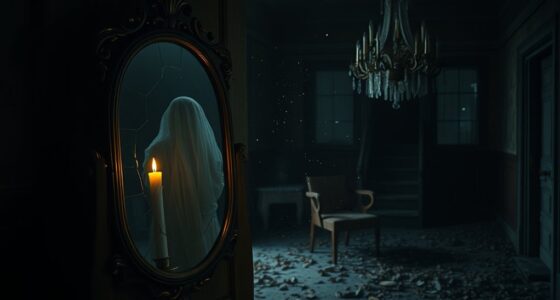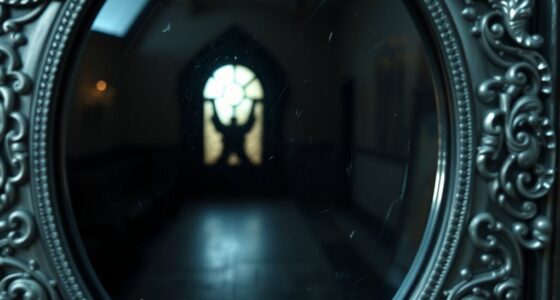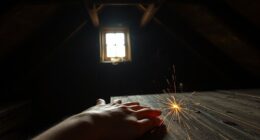Old houses are often haunted due to their rich history, creaking floorboards, and dark corners that echo the past. Many Victorian homes, with their intricate architecture, have been tied to spiritualism and practices like séances, enhancing their eerie reputations. As you explore these homes, you’ll uncover unresolved stories and societal fears that linger within their walls. There’s more to these fascinating structures than meets the eye, waiting for you to discover.
Key Takeaways
- Old houses, particularly Victorian homes, feature architectural elements that evoke eerie atmospheres, enhancing their haunted reputations.
- The average age of homes linked to hauntings is around 88 years, often associated with spiritualism and ghostly encounters.
- Historical practices like seances conducted in parlors contribute to the supernatural associations of these homes.
- Unresolved societal fears and past events are woven into the stories of old houses, symbolizing lingering anxieties.
- Neglect and decay over time lead to a negative reputation for Victorian homes, intertwining them with haunting narratives.
The Allure of Age: Why Old Houses Capture Our Imagination
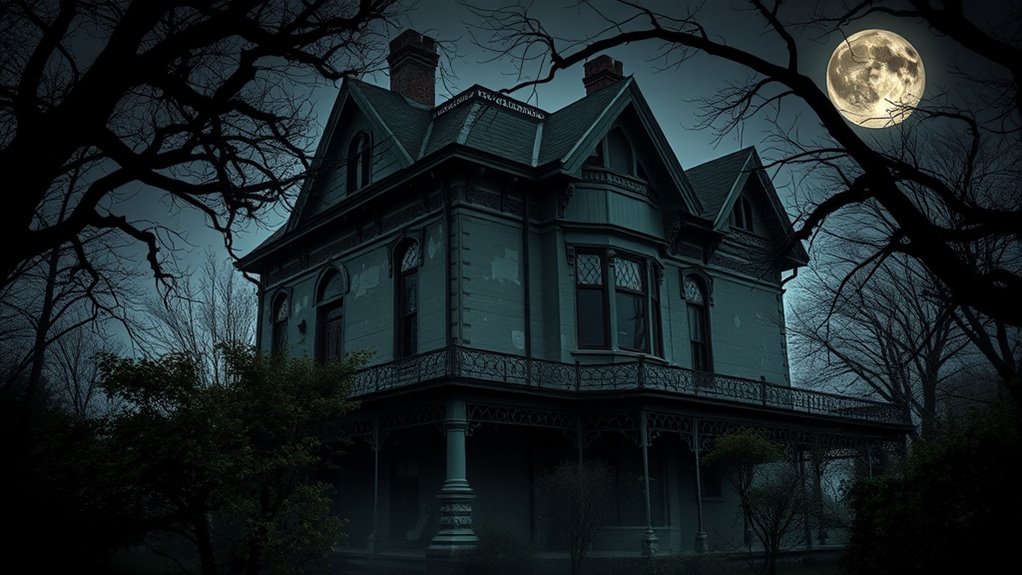
Old houses possess a unique charm that draws you in, igniting your curiosity about their past.
Particularly those built in the Victorian era, these homes showcase intricate architecture, with dark wood, long hallways, and creaking floorboards that create an eerie atmosphere.
As you explore, you can’t help but feel a connection to the ghost stories and unresolved events tied to these structures.
The cultural perception of old houses as haunted spaces, fueled by literature and media, enhances their allure.
You might find yourself captivated by the idea of encountering something supernatural, as the average age of homes associated with unusual experiences is around 88 years.
This fascination with haunted houses keeps your imagination alive and your curiosity piqued.
The Haunting History of Victorian Architecture
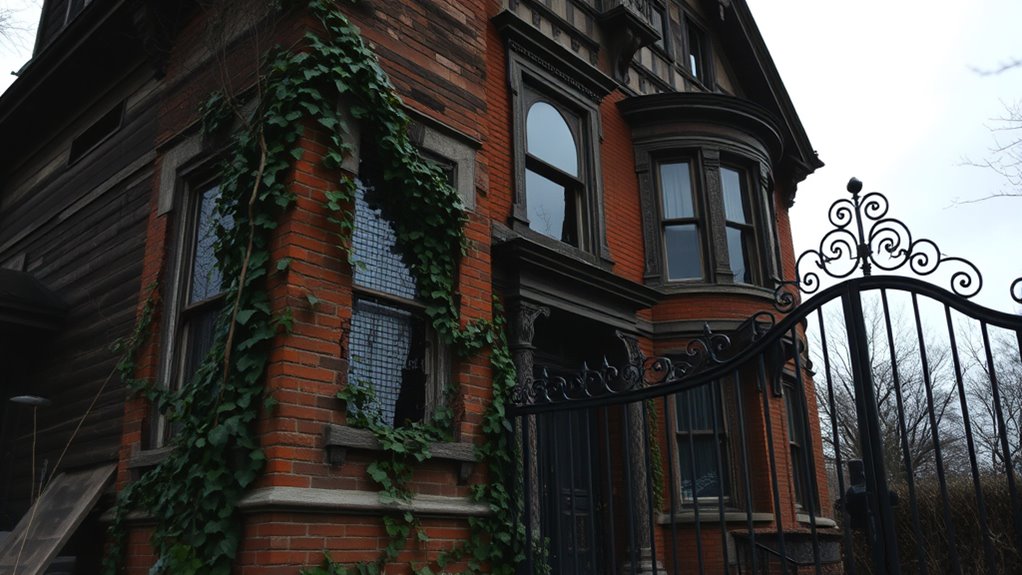
While many admire the stunning details of Victorian architecture, its rich history often hides a darker narrative.
Victorian homes, once symbols of elegance, have developed a reputation as haunted houses, largely due to their intricate architectural elements. The elaborate woodwork and labyrinthine layouts can evoke feelings of isolation, making these spaces seem eerie.
Additionally, practices like laying out the dead in parlors and hosting seances in these homes contributed to their ghostly associations. As Victorian homes fell into neglect, their decay further solidified their haunted image, capturing the attention of authors and artists.
Architectural Features That Create Eerie Atmospheres
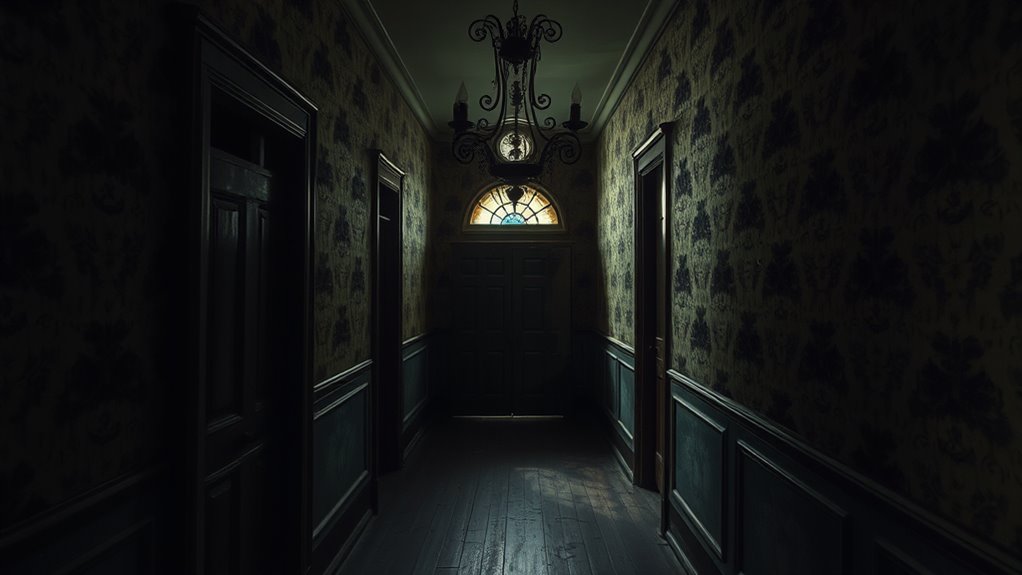
When you step into a Victorian house, the dark interior spaces and labyrinthine layouts can make you feel disoriented.
Ornate architectural details may catch your eye, but they also cast unsettling shadows that heighten the eeriness.
These elements together create an atmosphere that’s both alluring and unnerving, drawing you deeper into the home’s haunted history.
Dark Interior Spaces
Victorian homes are notorious for their dark interior spaces, which evoke a sense of unease and mystery. The combination of long hallways and dimly lit corners creates the perfect setting for ghostly encounters. Heavy building materials like dark wood, intricate woodwork, and stained glass windows contribute to this foreboding atmosphere.
| Architectural Feature | Effect on Atmosphere |
|---|---|
| Long Hallways | Heightens tension |
| Dark Wood | Enhances eeriness |
| Stained Glass Windows | Filters light, creates shadows |
| Towering Turrets | Imposes isolation |
| Hidden Rooms | Symbolizes hidden fears |
These aspects of Victorian architecture not only haunt the imagination but also reinforce the homes’ haunted reputations. You can’t help but feel the weight of their history in these shadowy spaces.
Labyrinthine Layouts
As you wander through a Victorian house, the labyrinthine layouts can easily disorient you, making every turn feel like a step deeper into a ghostly tale.
The intricate woodwork and dramatic roofs create a maze of long hallways and numerous corners, perfect for unexpected jump scares that heighten the eerie atmosphere.
Dark wood materials enhance this foreboding ambiance, leaving you feeling isolated and vulnerable.
Design elements like attics and hidden passages evoke entrapment, feeding the house’s haunted reputation.
Stained glass and thick draperies, while functional, cast ominous shadows and create unsettling lighting effects, adding to the overall sense of mystery.
In these Victorian homes, every twist and turn invites you to question what might be lurking just out of sight.
Ornate Architectural Details
The intricate architectural details of Victorian houses can amplify the eerie atmosphere, drawing you deeper into their haunting charm. Features like elaborate woodwork and stained glass windows not only captivate the eye but also create an ominous ambiance. As you wander the dimly lit halls, the creaking floorboards echo your every step, adding to the unsettling soundscape typical of haunted Victorian homes.
| Feature | Effect |
|---|---|
| Intricate Woodwork | Enhances foreboding feel |
| Stained Glass Windows | Creates ominous shadows |
| Long Hallways | Contributes to feelings of entrapment |
| Thick Draperies | Adds to the eerie atmosphere |
These ornate architectural details work together, crafting a space that feels alive with history and mystery.
Cultural Perceptions of Victorian Homes and Their Decline
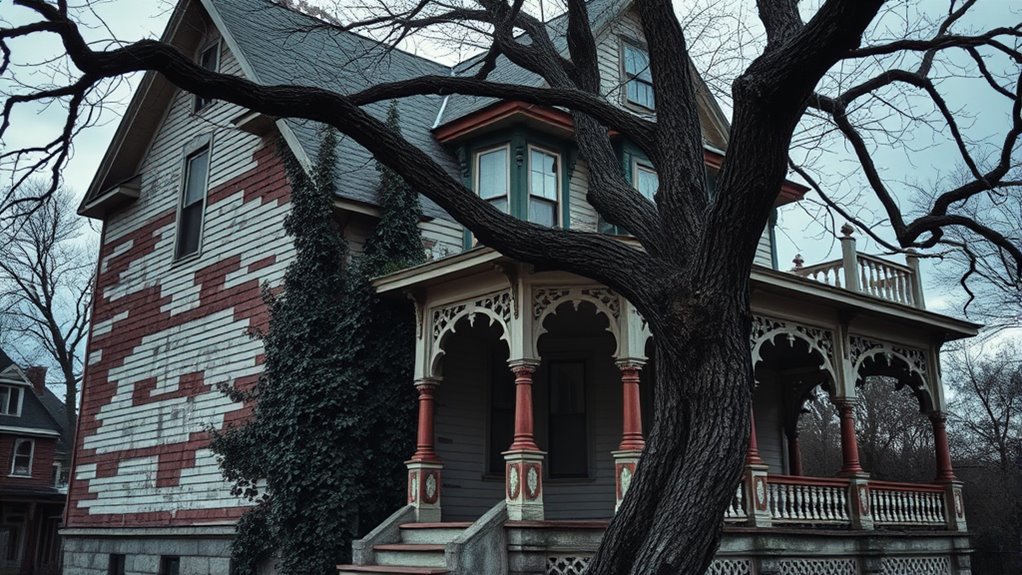
While once celebrated as symbols of affluence and elegance, many grand Victorian homes now evoke a sense of unease and decay.
Initially, these homes represented wealth, but as societal resentment grew towards their excess, their reputation soured. The decline of Victorian homes in popularity led to neglect, with many falling into disrepair and being repurposed into boarding houses.
This shift further entrenched their negative perceptions as haunted spaces. Architectural critics in the 1920s dismissed these ornate designs, favoring efficiency over the lavishness of the past.
As wealthier tenants moved out, Victorian homes became symbols of decline, their eerie associations deepening. The haunting narratives reflect not just architectural histories, but also unresolved societal issues and psychological burdens of the era.
The Connection Between Spiritualism and Haunted Houses
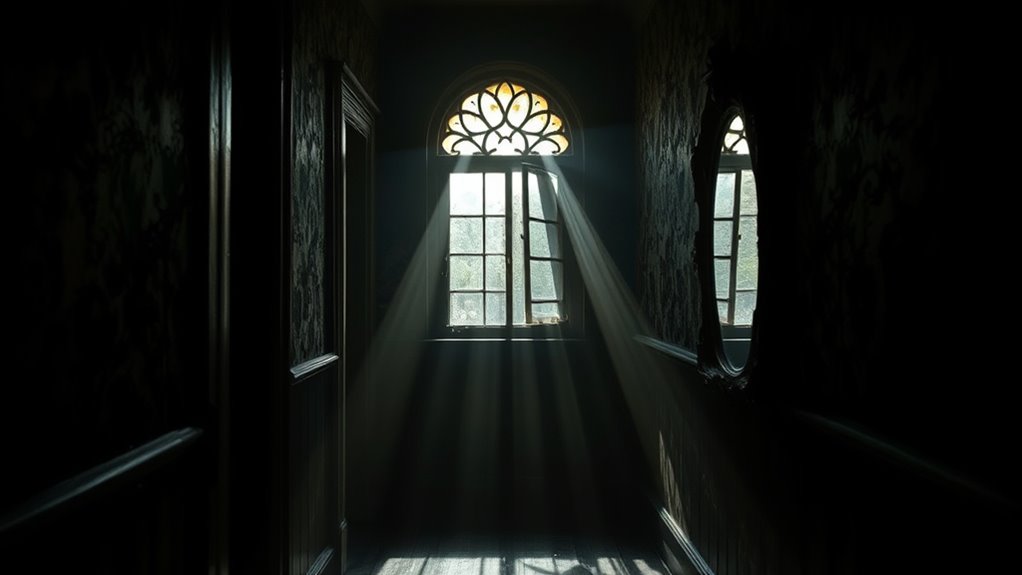
During the Victorian era, spiritualism became a sensation, making many people believe they could communicate with the dead.
This belief shaped how homes were viewed, turning private parlors into eerie spaces for seances and ghostly encounters.
With architectural features designed to connect with other dimensions, these houses became hotbeds for haunting tales that still captivate us today.
Spiritualism’s Rise in Popularity
As spiritualism emerged in the Victorian era, people increasingly sought connections with the deceased, shaping their views on haunted houses. This movement led to a fascination with the supernatural, especially in Victorian homes where seances often took place. Many believed these spaces were gateways to other dimensions, further enhancing their haunted reputation.
| Influence | Victorian Homes | Cultural Impact |
|---|---|---|
| Spiritualism’s Rise | Converted parlors | Beliefs in hauntings |
| Ghost Stories | Relatable narratives | Fear and fascination |
| Paranormal Activity | Unsettling experiences | Architectural links |
| Lingering Spirits | Unresolved past events | Popular culture status |
These elements combined to create a rich tapestry of beliefs, making haunted homes a staple in Victorian society.
Seances and Ghostly Encounters
Seances often transformed Victorian parlors into mystical spaces where people believed they could connect with the spirits of the deceased.
In these homes, the atmosphere was thick with the allure of spiritualism, as low lighting and hidden passages fostered an eerie ambiance. People gathered to share ghost stories, drawing on societal anxieties surrounding death and loss, which were deeply ingrained in Victorian culture.
The tradition of laying out the dead in family parlors only intensified this connection, making these spaces synonymous with mourning and potential hauntings.
As ghost stories flourished, they often featured ordinary Victorian homes, linking the supernatural to familiar settings and further establishing the haunted house phenomenon.
You can see how this era cemented the connection between spiritualism and the haunting narrative.
Architectural Influence on Beliefs
How did the architecture of Victorian homes shape beliefs about the supernatural?
The intricate architectural elements of Victorian houses, with their dark, isolating spaces like attics and long hallways, created an eerie atmosphere that fed into the cultural narrative of haunted houses.
During the Victorian era, spiritualism thrived, leading many to convert parlors into seance rooms, which were thought to serve as “doorways” to other dimensions.
The creaking woodwork and heavy materials often made inhabitants interpret these sounds as supernatural phenomena.
Additionally, the association of these homes with past wealth and decline intertwined with ghost stories, making Victorian houses relatable settings for those curious about the supernatural, ultimately reinforcing their haunted reputation.
The Role of Pop Culture in Shaping Haunted Narratives
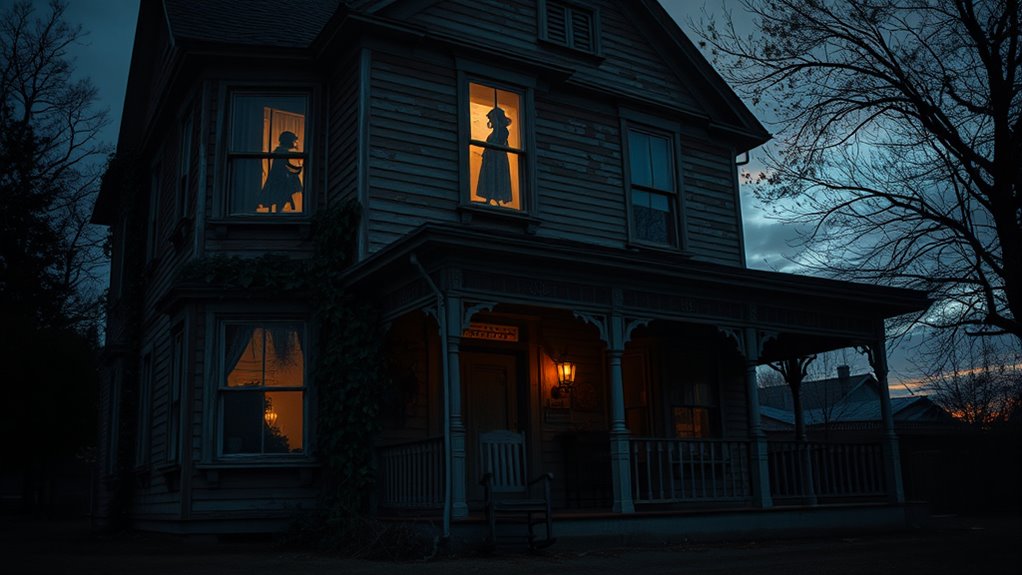
Pop culture has considerably shaped the narratives surrounding haunted houses, weaving together historical fears and contemporary storytelling. Early literature, like Edgar Allan Poe’s works, established Victorian homes as eerie settings ripe for ghostly tales.
Films such as Alfred Hitchcock’s “Psycho” reinforced this image, showcasing unsettling architectural elements that evoke dread. The excess and decline associated with Victorian architecture play into societal fears, making these homes ideal backdrops for hauntings.
Sounds like creaking floorboards and loose windows, often highlighted in pop culture, enhance the unsettling atmosphere, attracting thrill-seekers and horror fans alike.
As you explore these narratives, you’ll see how pop culture continues to evolve, intertwining the stories of haunted houses with our own anxieties about the past.
Unresolved Stories: How History Haunts Old Houses
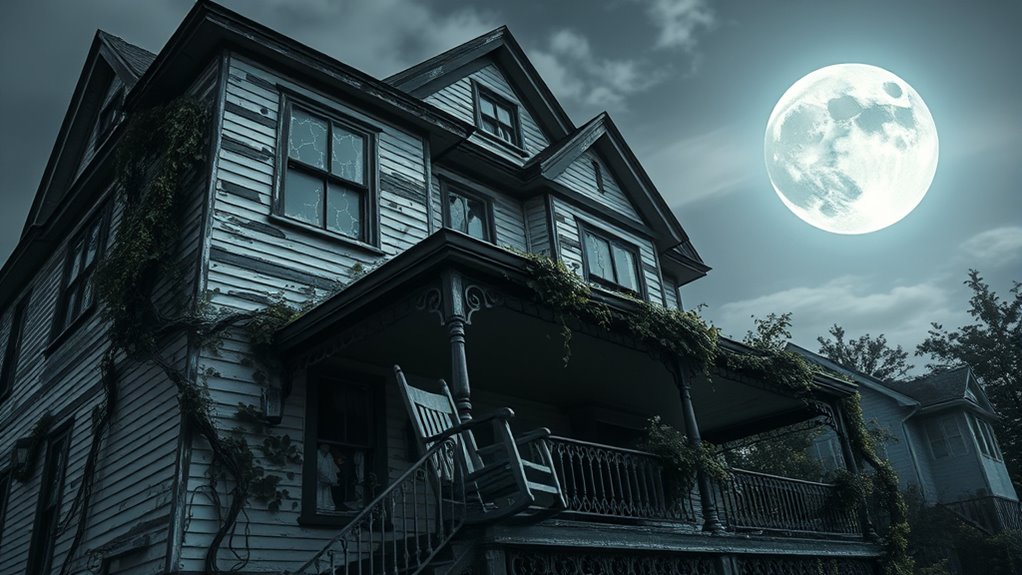
While many people might dismiss ghost stories as mere folklore, the truth is that haunted houses often embody unresolved histories that linger within their walls.
In Victorian homes, where the dead were laid out in family parlors, the connection between past events and present hauntings becomes evident. These structures accumulate stories tied to societal fears, such as wealth distribution and ethical dilemmas throughout American history.
The architectural features of Victorian homes—dark hallways and creaking floorboards—enhance their spooky reputations, making them prime settings for supernatural tales.
As you explore these haunted houses, you’ll find that the echoes of unresolved past events are woven into their very fabric, reminding us that history is never truly left behind.
Finding Beauty in the Shadows: The Appeal of Victorian Homes
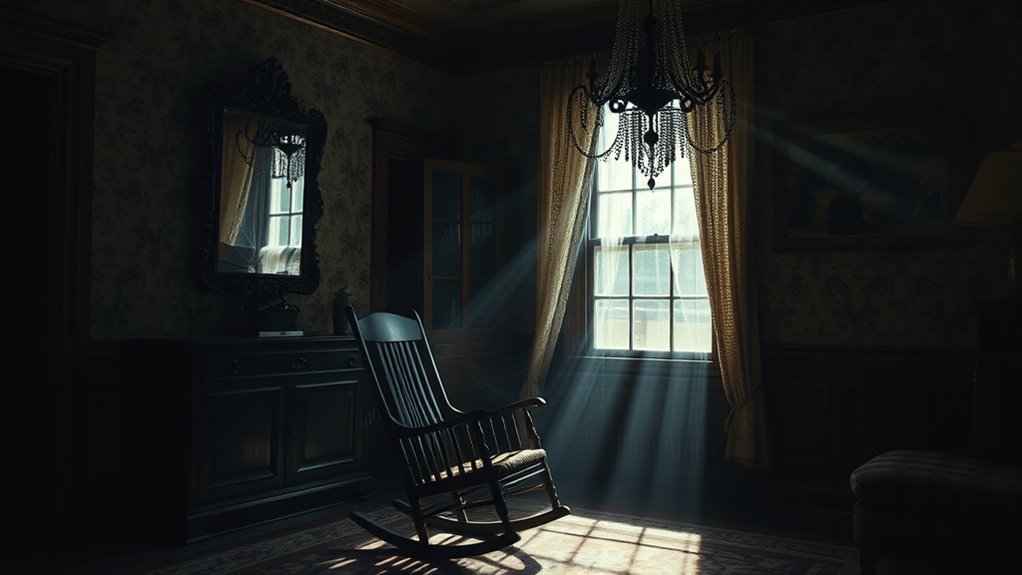
Victorian homes hold an allure that captivates many, even amidst their ghostly reputations. Their architectural beauty is undeniable, with intricate woodwork, vibrant colors, and dramatic roofs that draw you in.
Each style, from Queen Anne to Gothic Revival, showcases unique designs and ornate details that inspire awe. While some might envision dark, eerie spaces, well-kept Victorian homes often burst with cheerful hues and inviting interiors, like the charming Martha’s Vineyard Gingerbread Cottages.
You’ll also appreciate their historical significance, reflecting the rich socio-economic dynamics of the 19th century. As communities prioritize sustainability and efficient resource use, these enchanting structures continue to shine, proving that even homes with haunted reputations can embody beauty and charm, inviting you to explore their stories.
Frequently Asked Questions
Why Are Old Houses Haunted?
Old houses seem haunted for several reasons.
Their creaky floorboards and dimly lit hallways create an eerie atmosphere, making you more susceptible to feeling uneasy. You might hear strange noises, which can trigger your imagination, leading you to interpret everyday sounds as supernatural.
Plus, the rich histories tied to these homes often include unresolved events, adding to the stories that fuel beliefs about ghosts lurking in the shadows.
It’s a fascinating blend of history and your own perceptions.
Why Did Old Houses Have Secret Passages?
Imagine wandering through a maze of hidden doors and shadowy corridors, where every twist could lead to a secret treasure or a startled servant!
Old houses, especially Victorians, had secret passages for stealthy movement, privacy, and even spiritualist gatherings.
These concealed routes not only kept secrets safe but also added an air of mystery.
You might find yourself in a narrow hallway, heart racing, wondering what secrets lie behind the next hidden door!
Why Do Spirits Stay in Old Houses?
You might notice that spirits seem to linger in old houses because of the emotional ties and stories embedded in their walls.
These homes often carry unresolved histories, making them feel like a bridge between past and present.
Architectural features, like dark corners and hidden passages, can amplify your feelings of unease, leading you to believe that something is watching.
When you step inside, you might sense the echoes of lives once lived, creating a haunting atmosphere.
Are Old People’s Homes Haunted?
Imagine stepping into a time capsule; that’s how old people’s homes often feel. You might wonder if they’re haunted.
Many folks share stories about eerie noises, flickering lights, or objects mysteriously moving. While some experiences can be explained, the history and age of these homes certainly fuel the belief in spirits.
You’re not alone in feeling uneasy; a significant number of people believe these homes hold secrets and possibly even the lingering presence of past inhabitants.
Conclusion
In the end, old houses are like time capsules, whispering secrets of the past as you walk through their creaking halls. Just as the spirits of Dickens’ characters linger in the shadows, these homes hold unresolved stories that captivate our imagination. Their architectural charm and eerie atmospheres invite you to explore the beauty hidden within the gloom. So, the next time you pass by a Victorian gem, remember: history has a way of haunting us, even when it’s beautifully preserved.




